Almost any work dealing with armour of the 14th century illustrates a hundskull bascinet, and most show a klapvisor as well. Unfortunately, the klapvisor is almost exclusively German and Italian, and the hundskull dates from about 1370 and later. According to John Miles Paddock, in Arms and Armour of the Medieval Knight, early bascinets were fitted with globular visors, but the only example that I have been able to find is that on the brass of Sir Hugh Hastings (c. 1347). The visor of Sir Hugh is rather poorly depicted in my opinion, but some of the smaller figures along the edge have visors rather like a side pivoting version of an early klapvisor.
Does anyone know of other depictions of these apparently rare globular visors?
Also, I know that Valentine Armouries produces this replica, but it looks a bit more like a great bascinet visor to me. Does anyone know how accurate this particular visor is, and/or whether there are other manufacturers that produce early bascinet visors? Thanks.
-Grey
Hi Jason,
from what I have read and seen, the earlier visors on the bascinets were characterized by being smaller and barely covering the face. They were also not projecting forward like the pig-faced visors (also called hundsgugel or houndskull) but were rather rounded off and somewhat globular.
[ Linked Image ]
this is a line drawing of one of the best examples of the kind. The original is in the Valeria museum in Sitten Switzerland. I agree that the Valentine armouries visor reminds me of the great beacinets more than the earlier kinds. That being said, the Sitten helmet is dated to 1370.
i am aware of at least one more bascinet with similar visor in the Deutcshes Hisorisches museum. It is also dated to 1370.
Both of them are suspended by the klappvisier method.
This is one of the better repros I have seen.
[ Linked Image ]
This is the website
[ Linked Image ]
Here is another one from BestArmour
I have also seen period illustrations of bascinets with a more expanded nose-cone, but I do not think that this is what you are referring to. Example bellow. It is dated to very late 14th, early 15th century.
[ Linked Image ]
I hope that helps
from what I have read and seen, the earlier visors on the bascinets were characterized by being smaller and barely covering the face. They were also not projecting forward like the pig-faced visors (also called hundsgugel or houndskull) but were rather rounded off and somewhat globular.
[ Linked Image ]
this is a line drawing of one of the best examples of the kind. The original is in the Valeria museum in Sitten Switzerland. I agree that the Valentine armouries visor reminds me of the great beacinets more than the earlier kinds. That being said, the Sitten helmet is dated to 1370.
i am aware of at least one more bascinet with similar visor in the Deutcshes Hisorisches museum. It is also dated to 1370.
Both of them are suspended by the klappvisier method.
This is one of the better repros I have seen.
[ Linked Image ]
This is the website
[ Linked Image ]
Here is another one from BestArmour
I have also seen period illustrations of bascinets with a more expanded nose-cone, but I do not think that this is what you are referring to. Example bellow. It is dated to very late 14th, early 15th century.
[ Linked Image ]
I hope that helps
This was kindly sent to me as a reply to this thread by Brian Rainey form the Armour Research Society
| Quote: | ||||||
You are correct, early bascinet visors were globular and side-pivot/mount. The visors depicted in the Hasting’s brass are all, most likely, very similar to each other in shape and style. They show the same general globose shape and side-pivot attachment that is commonly attributed to the early 14th century, most notably England. England had the phenomenon of creating brasses that did not carry over to the rest of Europe, for some reason. These brasses are some of the earliest sources for 14th century bascinet visor research that we have to work from.. I highly recommend the Monumental Brass Society and their publications. Another source for similar visor depictions is the Romance of Alexander. Rounded side-pivot visors can be seen throughout the manuscript. The entire document can be viewed here in high resolution: Romance of Alexander
The Hastings brass and the Romance of Alexander are the common and readily available sources.
That visor is NOT similar to the early 14th century side-pivot visors. As you mentioned, it is similar in style to the visors of great bascinets that would have appeared around in first quarter of the 15th century, most similar to the following three examples: Museum of Navarre, circa 1425. See European Armour, Claude Blair. Musee de l’Armee, Paris, circa 1425. See Arms and Armour, Paul Martin. Musee de Beaux Arts, Dijon, circa 1410-40 (probably 1425-30, like above). Arms and Armour, Paul Martin. |
Last edited by Alexi Goranov on Wed 20 Apr, 2005 2:52 pm; edited 1 time in total
The sources Alexi mentions are the best for this. I have combed through the Romance of Alexander and have isolated some of the better images of these types of visors. Here they are:
 Attachment: 62.7 KB
Attachment: 62.7 KB
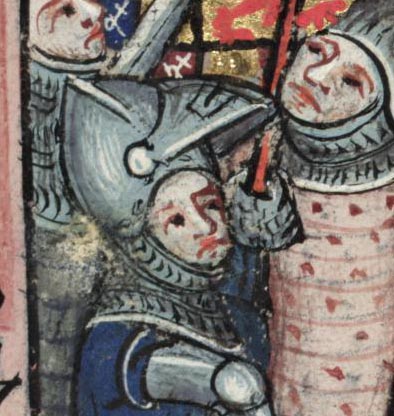
 Attachment: 42.89 KB
Attachment: 42.89 KB
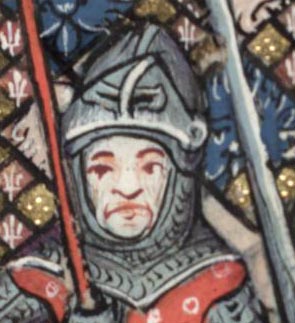
 Attachment: 47.04 KB
Attachment: 47.04 KB

 Attachment: 47.48 KB
Attachment: 47.48 KB
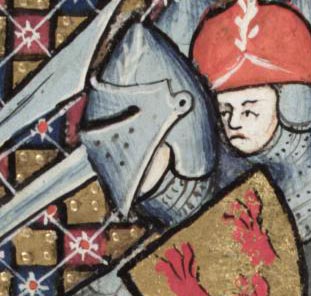




Here are some pictures of helmets from Musée de l'Armée, they are all (1-4) registered as been from the 14th century. I guess number 2 is what you are looking for?
 Attachment: 60.67 KB
Attachment: 60.67 KB

 Attachment: 70.61 KB
Attachment: 70.61 KB
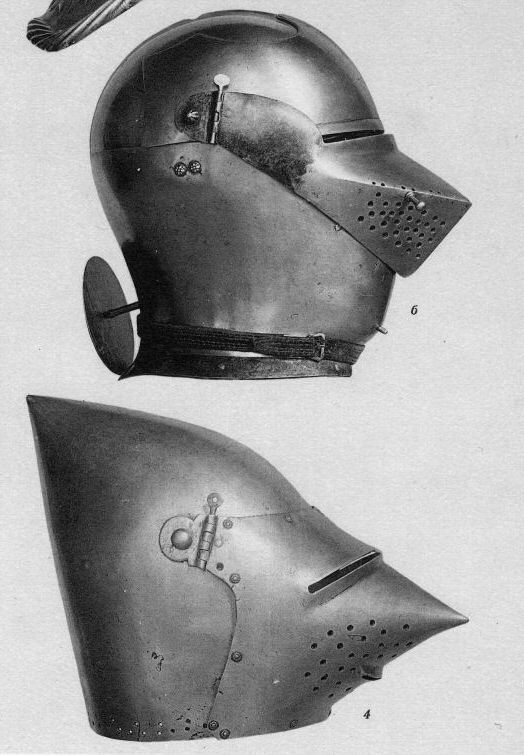
 Attachment: 42.01 KB
Attachment: 42.01 KB
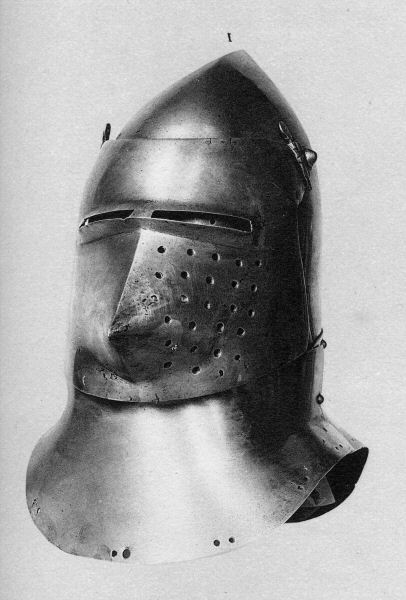



| Søren Niedziella wrote: |
| Here are some pictures of helmets from Musée de l'Armée, they are all (1-4) registered as been from the 14th century. I guess number 2 is what you are looking for? |
#2 looks more like a great bascinet to me than an early bascinet. #6 and #3 (numbers within the pictures not the actual order) are not basinets, at least according to me (I know you are not saying that they are). #6 is an armet, and #3 is a barbut with a visor.
The last basinet with the sheet metal aventail is a peculaiar example. There is another similar one in the Dodge's palace in Venice.
#4 (item number H21 in the museum inventory) )is a "typical" pig-face bascinet. I really like its the proportions.
thanks for posting these.
Alexi
Last edited by Alexi Goranov on Thu 21 Apr, 2005 7:47 am; edited 1 time in total
Another informative post from Brian Rainey of the ARS
| Quote: |
| Søren Niedziella,
On the helms you posted, all but one (possibly two) are from well into the 15th century: 1. This helm is a 15th century helm, most likely 1425-1450. It is of Italian style, but could have possibly been made elsewhere. The visor does not belong to it and is now displayed as a seperate and distinct piece. 2. This helm is also of 15th century origin. This would not be the type of helm that Greyson is looking for... being up to 80 years AFTER the time frame he mentioned (1440s). While the visor and helm appear to be authentic, I have doubts as to whether they go together. 3. Ths helm is a 15th century armet... not even close to a style of bascinet or 14th century helm. I am wondering if the book you refer to sis not actually classify these as 15th century helms, rather than 14th. 4. This IS a 14th century helm of a fairly standard pig-faced design. Most likely dated in the 1370-80s. There are some oddities about this helm... but it is not relevant to the current context. 5. This is a 15th century great bascinet with a pig-faced visor (1400-1415). The rivetted neck plates would lead me to believe that this helm was once a standard bascinet that was retrofit to the great bascinet style. As such, parts of this helm could have been made as early as 1470-80. I also have doubts as to the authenticity of the visor/helm combination. They may not belong together. Cheers! |
Thanks for all of the info, guys. Mr. Rainey's input in particular was very informative, and the Romance of Alexander does depict the type of visors I had expected to see based on the written description in Edge and Paddock's book.
Working on the belief that klapvisors are defined by method of attachment, rather than shape (after all, there are hundskull-shaped visors that use the exact same method of attachment), I traced (because I really can't draw) pictures of klapvisors (including the first two that Alexi posted, as they appear in Brian Price's Techniques of Medieval Armour Reproduction: The 14th Century). I then modified these pictures, so that the visor was attached via side pivots. The result was that I had basically drawn the visors that appear in the Romance of Alexander. Isn't vindication wonderful. :D
Now I just have to get the whole world behind me in undoing the misconception that the klapvisor is actually a type of visor; it is in fact a method of visor attachment. :p So what we really have are hundskull and globular (though I think "dished" describes these a little better) visors that can be attached via the side pivot or klap method. Somehow, I don't see myself winning enough support to change the existing nomenclature. :lol:
After I posted the original thread, I went back and looked through a couple more of my books. I found a couple of line drawings from the Hastings Brass, but not a whole lot else. I did find a picture in one book that showed a visored bascinet with a round face (I would call this one "globular" as it looked like half of a sphere, or globe), and an extention that would cover the throat/neck area (like the ones on the Hastings Brass, but with a more streamlined outline). The odd thing about this picture is that everything else in it appears to be late 13th century. The book that it is in does not cite the original, and all that the picture credits tell me is that the original is in the British Library. I'll try to post a picture of it if anyone is interested.
Thanks again!
-Grey
Working on the belief that klapvisors are defined by method of attachment, rather than shape (after all, there are hundskull-shaped visors that use the exact same method of attachment), I traced (because I really can't draw) pictures of klapvisors (including the first two that Alexi posted, as they appear in Brian Price's Techniques of Medieval Armour Reproduction: The 14th Century). I then modified these pictures, so that the visor was attached via side pivots. The result was that I had basically drawn the visors that appear in the Romance of Alexander. Isn't vindication wonderful. :D
Now I just have to get the whole world behind me in undoing the misconception that the klapvisor is actually a type of visor; it is in fact a method of visor attachment. :p So what we really have are hundskull and globular (though I think "dished" describes these a little better) visors that can be attached via the side pivot or klap method. Somehow, I don't see myself winning enough support to change the existing nomenclature. :lol:
After I posted the original thread, I went back and looked through a couple more of my books. I found a couple of line drawings from the Hastings Brass, but not a whole lot else. I did find a picture in one book that showed a visored bascinet with a round face (I would call this one "globular" as it looked like half of a sphere, or globe), and an extention that would cover the throat/neck area (like the ones on the Hastings Brass, but with a more streamlined outline). The odd thing about this picture is that everything else in it appears to be late 13th century. The book that it is in does not cite the original, and all that the picture credits tell me is that the original is in the British Library. I'll try to post a picture of it if anyone is interested.
Thanks again!
-Grey
Another one form Brian Rainey of the ARS
| Quote: | ||||
No problem, anytime. That is why we are here.
I am not certain what global misconception to which you are referring. It is generally and widely known that klappvisier is a descriptor for the style of mount on a visor. At times, when a visor is referenced, there are generalizations performed... that might be what you are seeing. But the meaning of the word is very well known... or should be. It is published in thousands of places. Globular is not really a used term... not sure where you got it. Actually, the terms you are using, I have not heard used. Globose, maybe... but I would not use globular. The majority of anyone who knows anything about 14th century armour will not used a terms like globular. On "hundskull".... the correct and widely accepted modern term is "hounskull" which is most likely a bastardization of the German word hundsgugel (literal translation is "hound's hood"). BTW: It is a good thing to note here that other than a single literary reference (which is a parody of French troops from an English point of view in 1436/8, I believe), the English appear to not use descriptors for the visors... what we use is modern terminology. In English inventories you will only see "visored bascinets" or "visored helms". Try these: side-pivoted pig-faced visor klapvisor/klappvisier mounted pig-faced visor side-pivoted round-faced visor klapvisor/klappvisier mounted round-faced visor side-pivoted blunted pig-faced visor klapvisor/klappvisier mounted blunted (bullet-nosed) pig-faced visor These are good modern English descriptors for the types of visors. They were narrowed down by a friend of mine who is writing a book on existing 14th century armour. I would not use the word "dish" as a descriptor for style as that refer to a single type of metal shaping that could be used to get a particular shape... there are other ways to obtain the same shape. I HIGHLY recommend that you obtain a copy of European Armour - circa 1066 to circa 1700. Blair, Claude. This is the single most valuable reference available for general armour knowledge, period. If I were stranded on a desert Island and could only bring one book to read, it would be this one. Brian" |
Alexi's signature feels rather apt at the moment. Nonetheless, thank you for the corrections and insights. Looks like this will have to be one of those do-it-yourself projects for the future.
-Grey
-Grey
Page 1 of 1
You cannot post new topics in this forumYou cannot reply to topics in this forum
You cannot edit your posts in this forum
You cannot delete your posts in this forum
You cannot vote in polls in this forum
You cannot attach files in this forum
You can download files in this forum
All contents © Copyright 2003-2006 myArmoury.com — All rights reserved
Discussion forums powered by phpBB © The phpBB Group
Switch to the Full-featured Version of the forum
Discussion forums powered by phpBB © The phpBB Group
Switch to the Full-featured Version of the forum